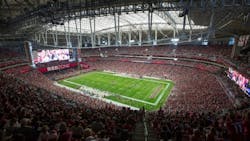NFL Super Bowl viewers will experience the benefits of LED-based SSL
Ephesus Lighting fixtures powered by Cree LEDs will illuminate the playing surface on Sunday at the University of Phoenix Stadium in Glendale, AZ.
Ephesus Lighting announced back in September 2014 that it had supplied LED-based fixtures for a lighting retrofit at the University of Phoenix Stadium in Glendale, AZ — home of the Arizona Cardinals National Football League (NFL) team. With the NFL Super Bowl approaching on Feb. 1, 2015, the solid-state lighting (SSL) project will come under global scrutiny. Of course, the lighting is critical for the players that will participate in the game. But the lighting will also influence the quality of the fan experience for the spectators in the stands and those watching on HDTV around the world.
Ephesus says the company and the stadium operators have worked continuously since the initial installation to optimize the lighting. Moreover, Ephesus has worked with the NBC TV production team for several weeks to ensure an optimal broadcast of both the game and the famed halftime show. Singing superstar Katy Perry will perform at halftime.
The stadium retrofit involved replacing 780 metal halide (MH) fixtures with only 312 SSL luminaires. The prior MH lighting delivered 148 fc on average at the playing surface. The new lighting maintains 277 fc while also delivering 75% energy savings.
"We are excited about replacing our metal halide fixtures with state-of-the-art Ephesus LED lighting fixtures," said Peter Sullivan, the stadium’s regional vice-president and general manager. "We look forward to demonstrating the benefits of LED technology to a global audience."
Ephesus Lighting founder and CTO Joe Casper described the benefits of LED lighting in such a venue, especially when it comes to the TV audience. He said that with MH lighting camera operators had to manually adjust the aperture settings, allowing as much light as possible. The LED lighting will allow for reduced aperture settings and a better focal plane, according to Casper.
Solid-state lighting will also allow a more accurate presentation of colors to the TV audience, added Casper. He noted that the LED-based SSL products come much closer to the lighting effects of natural daylight. "We help find the true color," said Casper. "We can take an indoor environment and make it look like they’re playing outside."
Cree also issued a statement about the stadium’s solid-state lighting. The company said that 44,928 XLamp MK-R LEDs are utilized in the stadium lighting. The 310-kW system replaced the prior 1.24-MW system.
Sports venues are one of the last lighting applications to be penetrated by LED technology due to the cost and weight of SSL products that can deliver the required light output. But clearly the scene is changing. English Premier League soccer powerhouse Chelsea lit its playing surface with LED-based solid-state lighting last year and also cited the HDTV experience as a reason. And just earlier this week we covered an LED lighting project at the Seattle Mariners Major League Baseball stadium.

Maury Wright | Editor in Chief
Maury Wright is an electronics engineer turned technology journalist, who has focused specifically on the LED & Lighting industry for the past decade. Wright first wrote for LEDs Magazine as a contractor in 2010, and took over as Editor-in-Chief in 2012. He has broad experience in technology areas ranging from microprocessors to digital media to wireless networks that he gained over 30 years in the trade press. Wright has experience running global editorial operations, such as during his tenure as worldwide editorial director of EDN Magazine, and has been instrumental in launching publication websites going back to the earliest days of the Internet. Wright has won numerous industry awards, including multiple ASBPE national awards for B2B journalism excellence, and has received finalist recognition for LEDs Magazine in the FOLIO Eddie Awards. He received a BS in electrical engineering from Auburn University.





